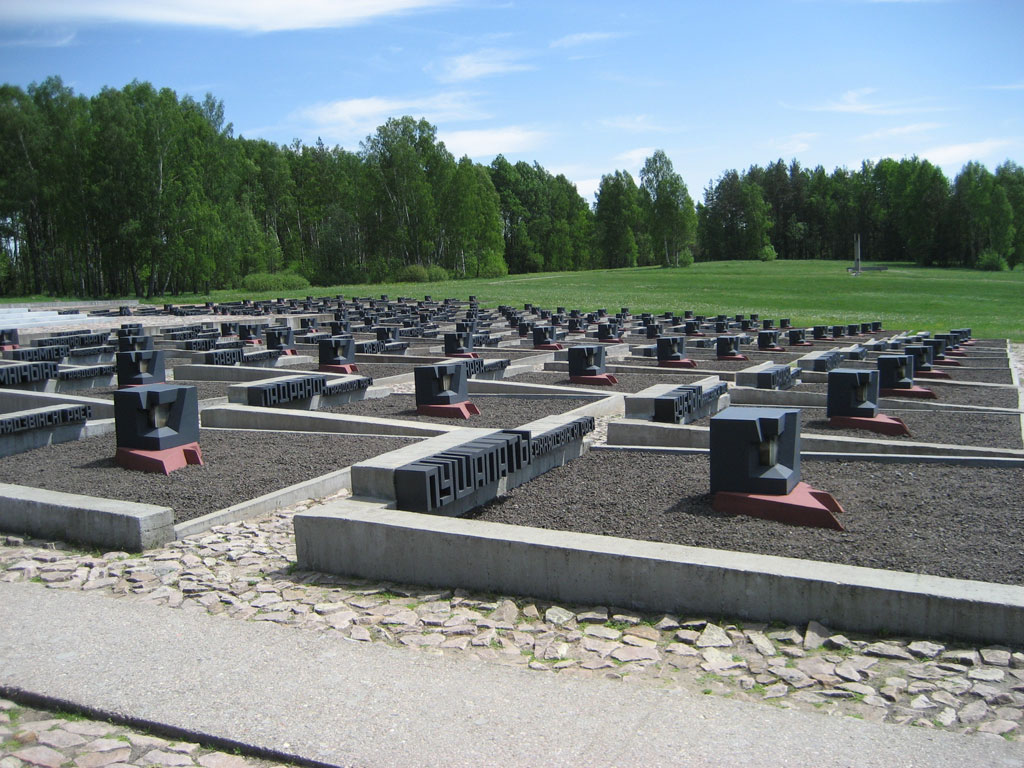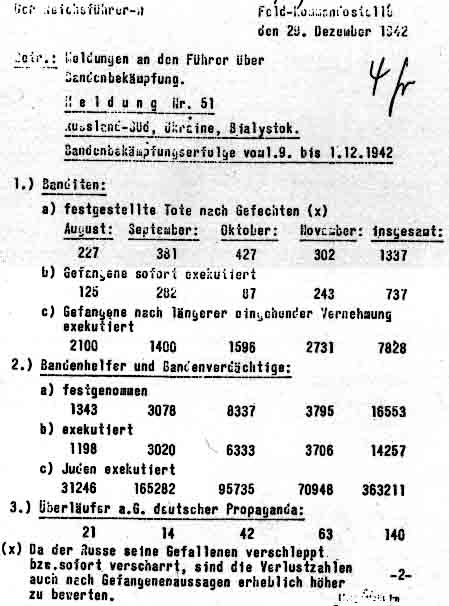|
Khatyn Massacre
Khatyn ( be, Хаты́нь, Chatyń, ; russian: Хаты́нь, ) was a village of 26 houses and 157 inhabitants in Belarus, in Lahoysk Raion, Minsk Region, 50 km away from Minsk. On 22 March 1943, almost the entire population of the village was massacred by the Schutzmannschaft Battalion 118 in retaliation for an attack on German troops by Soviet partisans. The battalion was composed of primarily Ukrainian nationalist Nazi collaborators and assisted by the Dirlewanger Waffen-SS special battalion.Zur Geschichte der Ordnungspolizei 1936–1942, Teil II, Georg Tessin, Dies Satbe und Truppeneinheiten der Ordnungspolizei, Koblenz 1957, s. 172–173 Background The massacre was not an unusual incident in Belarus during World War II. At least 5,295 Belarusian settlements were burned and destroyed by the Nazis, and often all their inhabitants were killed (some amounting to as many as 1,500 victims) as a punishment for collaboration with partisans. In the Vitebsk region, 243 vi ... [...More Info...] [...Related Items...] OR: [Wikipedia] [Google] [Baidu] |
Eastern Front Of World War II
The Eastern Front of World War II was a theatre of conflict between the European Axis powers against the Soviet Union (USSR), Poland and other Allies, which encompassed Central Europe, Eastern Europe, Northeast Europe (Baltics), and Southeast Europe (Balkans) from 22 June 1941 to 9 May 1945. It was known as the Great Patriotic War in the Soviet Union – and still is in some of its successor states, while almost everywhere else it has been called the ''Eastern Front''. In present-day German and Ukrainian historiography the name German-Soviet War is typically used. The battles on the Eastern Front of the Second World War constituted the largest military confrontation in history. They were characterised by unprecedented ferocity and brutality, wholesale destruction, mass deportations, and immense loss of life due to combat, starvation, exposure, disease, and massacres. Of the estimated 70–85 million deaths attributed to World War II, around 30 million occurred on th ... [...More Info...] [...Related Items...] OR: [Wikipedia] [Google] [Baidu] |
Senior Lieutenant
Senior lieutenant is a military grade between a lieutenant and a captain, often used by countries from the former Eastern Bloc. It is comparable to first lieutenant. Finland ( sv, premiärlöjtnant) is a Finnish military rank above ( sv, löjtnant) and below ( sv, kapten). It is used in the Finnish Defence Forces (army, navy and air force) and the Finnish Border Guard. The prescribed duty is a company vice-commander. Officers who have graduated as Bachelors of Military Science from the National Defence College with the rank of usually re-enter the college after four years' tour of duty. After a study of two additional years, they are promoted and return to more challenging duties. is also the highest rank available to those educated in the now-decommissioned school (comparable to a military junior college). History and related ranks The Army of the Finnish Grand Duchy of the Russian Empire had a rank of , similar in use as Prussian and Russian . The rank of came to Fi ... [...More Info...] [...Related Items...] OR: [Wikipedia] [Google] [Baidu] |
Red Army
The Workers' and Peasants' Red Army (Russian: Рабо́че-крестья́нская Кра́сная армия),) often shortened to the Red Army, was the army and air force of the Russian Soviet Federative Socialist Republic and, after 1922, the Union of Soviet Socialist Republics. The army was established in January 1918. The Bolsheviks raised an army to oppose the military confederations (especially the various groups collectively known as the White Army) of their adversaries during the Russian Civil War. Starting in February 1946, the Red Army, along with the Soviet Navy, embodied the main component of the Soviet Armed Forces; taking the official name of "Soviet Army", until its dissolution in 1991. The Red Army provided the largest land force in the Allied victory in the European theatre of World War II, and its invasion of Manchuria assisted the unconditional surrender of Imperial Japan. During operations on the Eastern Front, it accounted for 75–80% of casual ... [...More Info...] [...Related Items...] OR: [Wikipedia] [Google] [Baidu] |
Junior Lieutenant
Junior lieutenant is a junior officer rank in several countries, equivalent to Sub-lieutenant. Germany In the National People's Army, the rank of () was introduced in 1956. Eastern Europe In many Eastern European countries, the rank of junior lieutenant is used. Russia The rank of Junior lieutenant (russian: Mла́дший лейтена́нт, Mládshiy leytenánt) was introduced into the Russian military in 1937. Junior lieutenant insignia Army insignia File:9.AzAF-JLT.png, (Azerbaijani Land Forces) File:Post-Soviet-Army-OF-1a.svg, (Belarusian Ground Forces) File:10.RBrLF-2LT.svg, (Royal Brunei Land Forces) File:07.Kyrgyzstan Army-JLT.svg, (Kyrgyz Army) File:Malaysia-army-OF-1a.svg, (Malaysian Army) File:Russia-Army-OF-1a-2010.svg, (Russian Ground Forces) File:Post-Soviet-Army-OF-1a.svg, (Tajik National Army) File:Post-Soviet-Army-OF-1a.svg, (Turkmen Ground Forces) File:UA shoulder mark 11.svg, (Ukrainian Ground Forces) See also * Podporuchik ''Podporuchik'' ( sh-Cyrl ... [...More Info...] [...Related Items...] OR: [Wikipedia] [Google] [Baidu] |
NKVD
The People's Commissariat for Internal Affairs (russian: Наро́дный комиссариа́т вну́тренних дел, Naródnyy komissariát vnútrennikh del, ), abbreviated NKVD ( ), was the interior ministry of the Soviet Union. Established in 1917 as NKVD of the Russian Soviet Federative Socialist Republic, the agency was originally tasked with conducting regular police work and overseeing the country's prisons and labor camps. It was disbanded in 1930, with its functions being dispersed among other agencies, only to be reinstated as an all-union commissariat in 1934. The functions of the OGPU (the secret police organization) were transferred to the NKVD around the year 1930, giving it a monopoly over law enforcement activities that lasted until the end of World War II. During this period, the NKVD included both ordinary public order activities, and secret police activities. The NKVD is known for its role in political repression and for carrying out the Great ... [...More Info...] [...Related Items...] OR: [Wikipedia] [Google] [Baidu] |
Riga Trial
The Riga Trial was a war crimes trial held in front of a Soviet military tribunal between 26 January and 3 February 1946 in Riga, Latvian Soviet Socialist Republic, Soviet Union against six high ranking Wehrmacht officers, Höheren SS- und Polizeiführer Friedrich Jeckeln and SA-Standartenführer Alexander Boecking. All eight defendants were found guilty of war crimes during the German–Soviet War of 1941–45 and sentenced to death. They were publicly hanged immediately after sentencing. Only Wolfgang von Ditfurth escaped execution due to bad health. He died in prison from heart failure on 22 March 1946. Proceedings Unlike some previous trials, the prosecutors wanted to and were able to prove concretely that the main defendant, Jeckeln, was responsible for the crimes of which he was accused. Thus Jeckeln, a Nazi "race warrior" who oversaw the Rumbula massacre in Latvia, could be proven guilty on the basis of his own statements, as well as testimonies of other participants ... [...More Info...] [...Related Items...] OR: [Wikipedia] [Google] [Baidu] |
Khatyn National Memorial Complex - Near Minsk - Belarus - 10 (26971844114)
Khatyn ( be, Хаты́нь, Chatyń, ; russian: Хаты́нь, ) was a village of 26 houses and 157 inhabitants in Belarus, in Lahoysk Raion, Minsk Region, 50 km away from Minsk. On 22 March 1943, almost the entire population of the village was massacred by the Schutzmannschaft Battalion 118 in retaliation for an attack on German troops by Soviet partisans. The battalion was composed of primarily Ukrainian nationalist Nazi collaborators and assisted by the Dirlewanger Waffen-SS special battalion.Zur Geschichte der Ordnungspolizei 1936–1942, Teil II, Georg Tessin, Dies Satbe und Truppeneinheiten der Ordnungspolizei, Koblenz 1957, s. 172–173 Background The massacre was not an unusual incident in Belarus during World War II. At least 5,295 Belarusian settlements were burned and destroyed by the Nazis, and often all their inhabitants were killed (some amounting to as many as 1,500 victims) as a punishment for collaboration with partisans. In the Vitebsk region, 243 vi ... [...More Info...] [...Related Items...] OR: [Wikipedia] [Google] [Baidu] |
Bandenbekämpfung
In German military history, ''Bandenbekämpfung'' (German; ), also Nazi security warfare (during World War II), refers to the concept and military doctrine of countering resistance or insurrection in the rear area during wartime through extreme brutality. The doctrine provided a rationale for disregarding the established laws of war and for targeting of any number of groups, from armed guerrillas to the civilian population, as "bandits" or "members of gangs". As applied by the German Empire and later by Nazi Germany, it became instrumental in the mass crimes against humanity committed by the two regimes, including the Herero and Namaqua genocide and the Holocaust. Emergence Concept and origins According to historian and television documentary producer, Christopher Hale, there are indications that the term ''Bandenbekämpfung'' may go back as far as the Thirty Years' War. Under the German Empire established by Bismarck in 1871 after the Franco-Prussian War—formed as a ... [...More Info...] [...Related Items...] OR: [Wikipedia] [Google] [Baidu] |
Hans Woellke
Hans-Otto Woellke (18 February 1911 – 22 March 1943) was a German shot putter, who won a gold medal at the 1936 Summer Olympics and a bronze medal at the 1938 European Championships. Woellke served with the Order Police. During World War II, he was a captain in the Schutzmannschaft Battalion 118 attached to a regiment in the Waffen-SS. He was killed by partisans on 22 March 1943 near Khatyn village, after which a retaliatory mass killing Mass killing is a concept which has been proposed by genocide scholars who wish to define incidents of non-combat killing which are perpetrated by a government or a state. A mass killing is commonly defined as the killing of group members withou ... of civilians took place by Schutzmannschaft and Waffen-SS soldiers.Genocide Policy khatyn.by Referen ...
|
Minsk
Minsk ( be, Мінск ; russian: Минск) is the capital and the largest city of Belarus, located on the Svislach and the now subterranean Niamiha rivers. As the capital, Minsk has a special administrative status in Belarus and is the administrative centre of Minsk Region (voblast) and Minsk District (raion). As of January 2021, its population was 2 million, making Minsk the 11th most populous city in Europe. Minsk is one of the administrative capitals of the Commonwealth of Independent States (CIS) and the Eurasian Economic Union (EAEU). First documented in 1067, Minsk became the capital of the Principality of Minsk before being annexed by the Grand Duchy of Lithuania in 1242. It received town privileges in 1499. From 1569, it was the capital of the Minsk Voivodeship, an administrative division of the Polish–Lithuanian Commonwealth. It was part of a region annexed by the Russian Empire in 1793, as a consequence of the Second Partition of Poland. From 1919 to 1991, aft ... [...More Info...] [...Related Items...] OR: [Wikipedia] [Google] [Baidu] |
Vitebsk
Vitebsk or Viciebsk (russian: Витебск, ; be, Ві́цебск, ; , ''Vitebsk'', lt, Vitebskas, pl, Witebsk), is a city in Belarus. The capital of the Vitebsk Region, it has 366,299 inhabitants, making it the country's fourth-largest city. It is served by Vitebsk Vostochny Airport and Vitebsk Air Base. History Before 1945 Vitebsk developed from a river harbor where the Vićba River (Віцьба, from which it derives its name) flows into the larger Daugava River, Western Dvina, which is spanned in the city by the Kirov Bridge. Archaeological research indicates that Baltic tribes had settlements at the mouth of Vitba. In the 9th century, Slavic settlements of the tribal union of the Krivichs replaced them. According to the ''Chronicle of Michael Brigandine'' (1760), Princess Olga of Kiev founded Vitebsk (also recorded as Dbesk, Vidbesk, Videbsk, Vitepesk, or Vicibesk) in 974. Other versions give 947 or 914. Academician Boris Rybakov and historian Leonid Alekseyev ha ... [...More Info...] [...Related Items...] OR: [Wikipedia] [Google] [Baidu] |





